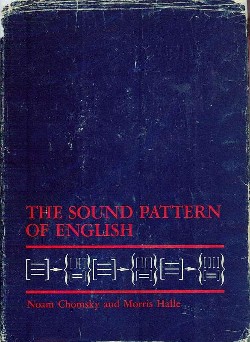Related Research Articles

Evolutionary linguistics or Darwinian linguistics is a sociobiological approach to the study of language. Evolutionary linguists consider linguistics as a subfield of sociobiology and evolutionary psychology. The approach is also closely linked with evolutionary anthropology, cognitive linguistics and biolinguistics. Studying languages as the products of nature, it is interested in the biological origin and development of language. Evolutionary linguistics is contrasted with humanistic approaches, especially structural linguistics.
Phonology is the branch of linguistics that studies how languages or dialects systematically organize their sounds or, for sign languages, their constituent parts of signs. The term can also refer specifically to the sound or sign system of a particular language variety. At one time, the study of phonology related only to the study of the systems of phonemes in spoken languages, but may now relate to any linguistic analysis either:
In linguistics, syntax is the study of how words and morphemes combine to form larger units such as phrases and sentences. Central concerns of syntax include word order, grammatical relations, hierarchical sentence structure (constituency), agreement, the nature of crosslinguistic variation, and the relationship between form and meaning (semantics). There are numerous approaches to syntax that differ in their central assumptions and goals.

The Sound Pattern of English is a 1968 work on phonology by Noam Chomsky and Morris Halle. In spite of its title, it presents not only a view of the phonology of English, but also contains discussions of a large variety of phonological phenomena of many other languages. The index lists about 100 such languages. It has been very influential in both the field of phonology and in the analysis of the English language. Chomsky and Halle present a view of phonology as a linguistic subsystem, separate from other components of the grammar, that transforms an underlying phonemic sequence according to rules and produces as its output the phonetic form that is uttered by a speaker. The theory fits with the rest of Chomsky's early theories of language in the sense that it is transformational; as such it serves as a landmark in Chomsky's theories by adding a clearly articulated theory of phonology to his previous work which focused on syntax.
In linguistics, transformational grammar (TG) or transformational-generative grammar (TGG) is part of the theory of generative grammar, especially of natural languages. It considers grammar to be a system of rules that generate exactly those combinations of words that form grammatical sentences in a given language and involves the use of defined operations to produce new sentences from existing ones. The method is commonly associated with American linguist Noam Chomsky.

Generative grammar, or generativism, is a linguistic theory that regards linguistics as the study of a hypothesised innate grammatical structure. It is a biological or biologistic modification of earlier structuralist theories of linguistics, deriving ultimately from glossematics. Generative grammar considers grammar as a system of rules that generates exactly those combinations of words that form grammatical sentences in a given language. It is a system of explicit rules that may apply repeatedly to generate an indefinite number of sentences which can be as long as one wants them to be. The difference from structural and functional models is that the object is base-generated within the verb phrase in generative grammar. This purportedly cognitive structure is thought of as being a part of a universal grammar, a syntactic structure which is caused by a genetic mutation in humans.

Ray Jackendoff is an American linguist. He is professor of philosophy, Seth Merrin Chair in the Humanities and, with Daniel Dennett, co-director of the Center for Cognitive Studies at Tufts University. He has always straddled the boundary between generative linguistics and cognitive linguistics, committed to both the existence of an innate universal grammar and to giving an account of language that is consistent with the current understanding of the human mind and cognition.

Syntactic Structures is an influential work in linguistics by American linguist Noam Chomsky, originally published in 1957. It is an elaboration of his teacher Zellig Harris's model of transformational generative grammar. A short monograph of about a hundred pages, Chomsky's presentation is recognized as one of the most significant studies of the 20th century. It contains the now-famous sentence "Colorless green ideas sleep furiously", which Chomsky offered as an example of a grammatically correct sentence that has no discernible meaning. Thus, Chomsky argued for the independence of syntax from semantics.

John Robert "Haj" Ross is an American poet and linguist. He played a part in the development of generative semantics along with George Lakoff, James D. McCawley, and Paul Postal. He was a professor of linguistics at MIT from 1966–1985 and has worked in Brazil, Singapore and British Columbia, and until spring 2021, he taught at the University of North Texas.
In linguistics, linguistic competence is the system of unconscious knowledge that one knows when they know a language. It is distinguished from linguistic performance, which includes all other factors that allow one to use one's language in practice.
A diaphoneme is an abstract phonological unit that identifies a correspondence between related sounds of two or more varieties of a language or language cluster. For example, some English varieties contrast the vowel of late with that of wait or eight. Other English varieties contrast the vowel of late or wait with that of eight. This non-overlapping pair of phonemes from two different varieties can be reconciled by positing three different diaphonemes: A first diaphoneme for words like late, a second diaphoneme for words like wait, and a third diaphoneme for words like eight.

Joan Lea Bybee is an American linguist and professor emerita at the University of New Mexico. Much of her work concerns grammaticalization, stochastics, modality, morphology, and phonology. Bybee is best known for proposing the theory of usage-based phonology and for her contributions to cognitive and historical linguistics.
Formal semantics is the study of grammatical meaning in natural languages using formal tools from logic and theoretical computer science. It is an interdisciplinary field, sometimes regarded as a subfield of both linguistics and philosophy of language. It provides accounts of what linguistic expressions mean and how their meanings are composed from the meanings of their parts. The enterprise of formal semantics can be thought of as that of reverse-engineering the semantic components of natural languages' grammars.

In linguistics, the term formalism is used in a variety of meanings which relate to formal linguistics in different ways. In common usage, it is merely synonymous with a grammatical model or a syntactic model: a method for analyzing sentence structures. Such formalisms include different methodologies of generative grammar which are especially designed to produce grammatically correct strings of words; or the likes of Functional Discourse Grammar which builds on predicate logic.
In linguistics, Optimality Theory is a linguistic model proposing that the observed forms of language arise from the optimal satisfaction of conflicting constraints. OT differs from other approaches to phonological analysis, such as autosegmental phonology and linear phonology (SPE), which typically use rules rather than constraints. OT models grammars as systems that provide mappings from inputs to outputs; typically, the inputs are conceived of as underlying representations, and the outputs as their surface realizations. It is an approach within the larger framework of generative grammar.
Liliane Madeleine Victor Haegeman ARB is a Belgian professor of linguistics at Ghent University. She received her PhD in English linguistics in 1981 from Ghent University, and has written numerous books and journal articles thereafter. Haegeman is best known for her contributions to the English generative grammar, with her book Introduction to Government and Binding Theory (1991) well established as the most authoritative introduction on the Principles and Parameters approach of generative linguistics. She is also acknowledged for her contributions to syntactic cartography, including works on the left periphery of Germanic languages, negation and discourse particles, and adverbial clauses. As a native speaker of West Flemish, her research has also touched upon the comparative study of English and West Flemish in terms of the subject position and its relation to the clausal structure.
Elena Anagnostopoulou is a Greek theoretical linguist and syntactician. She is currently Professor of Theoretical Linguistics at the University of Crete.
Phonology in Generative Grammar is a 1994 book by Michael Kenstowicz in which the author provides an introduction to phonology in the framework of generative grammar.
Generative Phonology: Description and Theory is a 1979 book by Michael Kenstowicz and Charles Kisseberth in which the authors provides an introduction to phonology in the framework of generative grammar.
Rudolf P. Botha is a South African linguist. He is Emeritus Professor of General Linguistics at Stellenbosch University and Honorary Professor of Linguistics at Utrecht University. Botha is best known for his works on the philosophy of linguistics.
References
- ↑ doctoral dissertation
- ↑ "Michael Kenstowicz". MIT Linguistics.
- ↑ Hall, Tracy (1995). "Michael Kenstowicz: Phonology in Generative Grammar. Cambridge:Blackwell, 1994. 704pp". Linguistics. 33 (3). doi:10.1515/ling.1995.33.3.579.
- ↑ Szpyra, Jolanta (1 July 1995). "Phonology in Generative Grammar: M. Kenstowicz, Cambridge, MA and Oxford, UK: Blackwell, 1994. xi + 704 pp. UK £ 17.99 (pb.). ISBN 1-55786-426-8". Lingua. 96 (2): 189–195. doi:10.1016/0024-3841(95)90019-5. ISSN 0024-3841.
- ↑ Dinnsen, Daniel A. (May 1995). "Kenstowicz Michael (1994). Phonology in generative grammar. Cambridge, Mass. & Oxford: Blackwell. Pp. ix + 704". Phonology. 12 (1): 131–134. doi:10.1017/S0952675700002402. ISSN 1469-8188. S2CID 61581024.
- ↑ Parker, Steve (1995). "Phonology in generative grammar. By MICHAEL KENSTOWICZ. Cambridge, Massachusetts: Blackwell Publishers, 1994. Cloth $64.95, paper $24.95" (PDF). Notes on Linguistics (68).
- ↑ "Natural Language & Linguistic Theory". Springer.